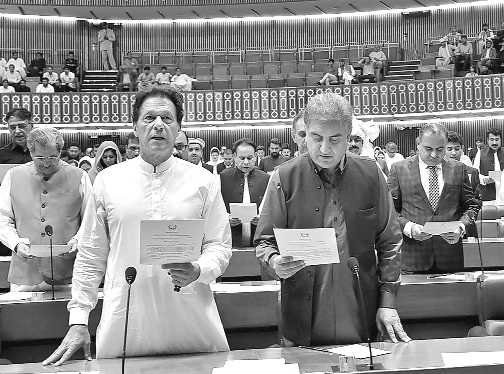The new Assembly is a motley crowd. It includes an ex-President, ex-PMs, seasoned Speakers, Punjabis with ambition, Sindhis with demands, Baluchis with recriminations and Pakhtuns with hopes

FS Aijazuddin
IF it was only for one year I should delight in it, but five is terribly long,” Lady Canning had written to her sister in June 1855, upon hearing that her husband Charles had been appointed Governor-General of India. That long-forgotten regret replayed on the face of Imran Khan as he and 327 MNAs-elect took their places in the National Assembly for their collective swearing-in on August 13. Imran Khan sat one seat away from the PM’s chair. After being sworn in as PM, he will be entitled to occupy it for the next five years. He has waited over 20 years for this “tryst with conspiracy”. Whatever plaudits should have been his, were appropriated that inaugural afternoon by PPP’s Bilawal Bhutto. Bilawal wafted in, innocent, confident, borne aloft by the memory of his mother Benazir Bhutto and the cunningness of his father Asif Ali Zardari. His unlikely neighbour in the same row, reserved for disappointed Opposition leaders, was Shahbaz Sharif, the PML’s surrogate stand-in for his brother Nawaz Sharif. (At that very moment, Nawaz Sharif was being driven from Adiala Jail to appear in a court on corruption charges.) Shahbaz looked a disconsolate Arjuna, pained that his elder brother had gambled away their political kingdom. Parties not in government now sit in the Opposition. They are as comfortable with each other as rival hedgehogs in an overcrowded pit. Other parties such as the MQM and five smaller regional ones who decided to swallow the cyanide of their scruples have joined Imran Khan on the government benches. This new National Assembly is a motley crowd. It includes a former President of Pakistan, ex-prime ministers, seasoned Speakers, Punjabis with ambition, Sindhis with demands, Baluchis with recriminations, Pakhtuns with hopes, and a recent PTI convert — a controversial TV presenter infamous for his venality — who groveled at the feet of his leader.Benazir Bhutto had adopted a white veil as her signature. Imran has decided to wear a white kurta-pyjama. In the National Assembly that afternoon, surrounded by baying hounds who wished him worse, he looked like a white stag, singular and vulnerable. One was reminded of Dom Moraes’ telling description of Indira Gandhi, flanked in the Lok Sabha by YB Chavan and Jagjivan Ram. He wrote: “She resembled a gazelle seated between two gorillas.” Had she been alive, her thoughts in Dom Moraes’ words would have been timely: “Formation of a Cabinet…is like the selection of a cricket team [.] It has to be a united whole, not a random selection of talented individuals.” Cricket continues to be the Kurukshetra of Indo-Pak relations. Imran has not invited PM Modi to his installation, but three Indian cricketers — Sunil Gavaskar, Kapil Dev and Navjot Singh Sidhu. The first two declined; the third — a TV laughing machine — has accepted. Indian High Commissioner Ajay Bisaria called on Imran Khan and presented him with a bat signed by the Indian cricket team. Only one of them (MS Dhoni) had reached his teens when Imran Khan’s team won the World Cup in 1992. The bat was a thoughtful gesture. Should Modi expect a tea set in return? Imran Khan, in his victory speech, has held out the assurance that “If India’s leadership is ready, we are ready to improve ties with India. If you forward one step, we will take two steps forward”. At the moment, both are wary. Neither is sure who might take the wrong step first. Elections divide communities; festivals unite them. This year Eid-ul-Azha (commemorating Abraham’s sacrifice) falls on August 22. For the next five such Eids, Pakistan’s Opposition parties share one aim: how to slaughter the white stag. — The writer is Pakistan-based historian
